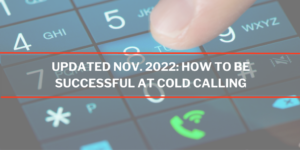
Updated Nov. 2022: How to Be Successful at Cold Calling
Let’s face it — cold calling isn’t for the faint of heart. But, it’s the one part of selling that you can’t avoid, no matter how many emails or LinkedIn messages you send. Luckily, mastering cold calling leads to wildly successful sales careers. Studies show that 44% of salespeople give up after the first phone call which means if you persevere, there’s less competition.
While some people argue cold calling is dead, it’s very much alive and a key driver for hitting revenue targets and achieving growth. Whether you’re new to sales, or just looking for some inspiration to keep going, here are nine tips for being successful at cold calling:
1. Contact the right person
Your time is valuable. If you’re going to spend it prepping for a phone call, spend just as much time finding the right decision-maker and accurate contact information. We see so many sales professionals waste time blindly dialing people hoping to get passed through to the appropriate person. While this might seem like a daunting task, there are tons of sales enablement platforms that do the heavy lifting for you. Sales intelligence tools like Winmo connect you with thousands of decision-makers, sourcing the data and human verifying it so your time is well spent.
With 25 to 30% of data becoming inaccurate each year, this is a resource that quickly pays back its investment.
2. Be polite and aware of your tone
This goes a long way. The people you contact have busy days filled with meetings and daily tasks with very little time to waste. When you finally get through to a prospect on the phone, start with thank you. When you thank someone for their time it instantly disarms the conversation and makes them feel in control of the call, and therefore more comfortable in continuing the conversation. Also, be aware of your tone. Studies show that your tone can determine how successful the cold call will be at an astonishing rate of 93%. Make sure you sound confident, present, and enthusiastic.
3. Tell a compelling story
Explain why your product or service is a solution to problems they are facing, and what investing in it could mean for their business. Don’t sell a product, sell a solution. Telling a story includes reacting to objections, which are bound to occur when selling to a decision-maker. The best way to pivot when an objection arises is to understand and tell the prospect you hear them, then tell a story of how your product can overcome those hurdles.
4. Know your numbers
In sales, it’s critical to have clearly defined goals in place — both on the revenue side and the activities that lead to revenue. For cold calling, you’ll need to know how many calls it will typically take you to hit your goals. You’ll also want to identify other points to ensure your cold-calling activity will lead to revenue:
- How many dials does it take you before you get a decision-maker on the phone?
- Did it turn into a discovery call or demo?
- Did it develop proposals or agreements?
It’s just as important to track those goals on a daily and weekly basis. If you’re only looking at these numbers on a monthly basis you’ve already lost an opportunity to correct downward trends.
5. Manage your time efficiently
When you finally do get a decision-maker on the phone it’s important to avoid hesitation and get straight to the point. You want to respect and honor the time of the person on the other end of the line, and also your own. The most successful sales reps write out a script ahead of time with suggested time allotments for each part of the conversation. Write this out and keep it in front of you for the call to ensure you’re running an efficient call and not rambling on.
A sample agenda could include:
- Introduction
- Connecting statement
- Reason for calling
- Qualifying
- Ask
To ensure you’re giving yourself the right about of time for the call itself, and to prep for it, put buffers on your calendar — maybe 30 minutes ahead of the call to prep and 15 minutes at the end in case the call runs over. There’s nothing worse than having a great call and trying to rush it at the end because you’ve scheduled back-to-backs that day.
6. Deliver value
Before you call someone, do your homework on their pain points. Speak to these difficulties and then determine how to position the value that your product or service could bring to their team. If you believe in the value of what you’re offering, this should come easily. By understanding the problems they are facing, you can better answer and explain why your product is not a “nice to have,” but a necessity.
You can also relate their current problem to one you are solving for an existing client. It will add credibility, and also help the prospect their concerns are solvable. By pointing out these similarities, the prospect also feels more comfortable moving forward with the conversation. Having trouble identifying these pain points? Resources like Winmo serve up forecasted lead opportunities based on sales triggers our team has identified. For example, if a brand is about to hire a new CMO this would be a prime opportunity to reach out and explain how your product or service could help them make an immediate impact.
7. Think outside the box
Being unique is half the battle. Decision-makers get spammed with calls all day. As much as possible, you want to try to make your cold call personalized and unique, or a combination of the two. How are you standing out from the pack? Do your research and see if they recently spoke at a conference or attended an event. Use details like that to start a conversation and stand out from the typical intro sentence of “Hi I’m Steve with Acme and want to talk to you about our product.”
Also, make sure you’re following up in different ways. Cold calling is important, but only one piece of your prospecting cadence. Follow up with a handwritten note, and throw in some swag if your marketing team has it. Find ways to keep the conversation going after the initial phone call.
8. Direct ask and clear next steps
Make sure that the action needed on their end is clearly stated before getting off the phone. Directly asking for a second meeting is the hardest part of cold calling for a lot of reps but it’s so important. If you’re able to get a second meeting scheduled before you hang up the likelihood of closing the deal increases significantly. When you directly ask, you give the prospect another opportunity to bring any other concerns or objections to the table. When it comes to the first conversation, the goal is not necessarily selling but instead getting more time on their calendars.
9. You have two ears and one mouth
When you get a prospect on the phone, especially for the first time, state your intentions but also listen. Guide the conversation down a path of learning more about their goals and further details of their pain points. I was recently in a sales training and heard, “You have two ears and one mouth – make sure you’re listening more than you’re talking.”
No doubt cold calling is tough. It takes grit and perseverance to get through to a prospect on the phone. But, if you’re successful in doing so it can change the likelihood of you being able to close the deal.





